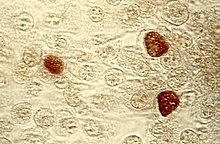Chlamydia (bacterium)
| Chlamydia | |
|---|---|
 |
|
| C. trachomatis inclusion bodies (brown) in a McCoy cell culture. | |
| Scientific classification | |
| Domain: | Bacteria |
| Phylum: | Chlamydiae |
| Class: | Chlamydiae |
| Order: | Chlamydiales |
| Family: | Chlamydiaceae |
| Genus: | Chlamydia |
| Species | |
|
Chlamydia muridarum Everett et al. 1999 |
|
Chlamydia muridarum Everett et al. 1999
Chlamydophila pecorum Fukushi & Hirai 1992, gen. nov. Everett et al. 1999
Chlamydia suis Everett et al. 1999
Chlamydia trachomatis (Busacca 1935) Rake 1957 emend. Everett et al. 1999
Chlamydia is a genus of pathogenic bacteria that are obligate intracellular parasites. Chlamydia infections are the most common bacterial sexually transmitted diseases in humans and are the leading cause of infectious blindness worldwide.
The three Chlamydia species include Chlamydia trachomatis (a human pathogen), Chlamydia suis (affects only swine), and Chlamydia muridarum (affects only mice and hamsters). Additionally, three species that were previously classified as Chlamydia have since 1999 been reclassified into the then newly created Chlamydophila genus: Chlamydophila psittaci, Chlamydophila pneumoniae, and Chlamydophila pecorum.
Because of Chlamydia's unique developmental cycle, it was taxonomically classified in a separate order.Chlamydia is part of the Chlamydiales order, Chlamydiaceae family. As of March 2008, a new chlamydial agent has been proposed to be introduced into the Chlamidiaceae family, namely "Candidatus Clavochlamydia salmonicola".
...
Wikipedia
